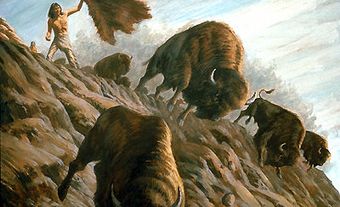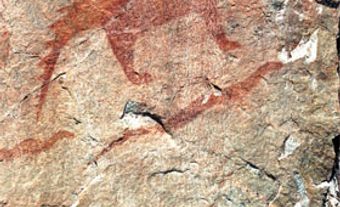The Droulers-Tsiionhiakwatha archaeological site is located in extreme southwest Québec, in Saint-Anicet in the Haut-Saint-Laurent area. The site was discovered by chance in the 1970s by the landowner at the time, François Droulers, but was only subjected to exploratory testing in 1993. Between 1994 and 1999, a large archaeological research project was undertaken at the site, in a partnership between the Québec Minister of Culture and Communications and the Municipalité régionale de comté Le Haut-Saint-Laurent. During this time, an archaeological team supervised by Michel Gagné, graduate of the University of Montreal, delimited the site and located the first longhouses.
Throughout the excavations, over 150 000 fragments of clay vessels, pipe bowls, stone and bone tools, food remains such as fish and mammal bones, and charred cultivated plant seeds were uncovered. This already impressive number of artifacts and ecofacts will continue to increase, as the field school of the Department of Anthropology of the University of Montreal has been taking place at the site since 2010. The scientific knowledge acquired from the archaeological evidence contributes to a better understanding of the adaptive system of the semi-sedentary populations in the St. Lawrence Valley during the Late Woodland Period (from 1000 to 1534 AD).
The Droulers-Tsiionhiakwatha site is associated with the presence of the St. Lawrence Iroquoians (see Aboriginal People: Eastern Woodlands), which belong to the vast linguistic and cultural Iroquoian family, like the Hurons-Wendats. This semi-permanent village site is the largest of its kind to be unearthed in Québec. Dating from the 15th century, it covers an area of about 1.3 ha and probably included about 10 longhouses regrouping approximately 600 individuals.
A typical longhouse at this site measured about 30 m in length and 6 m in width. Five to six aligned hearths sat right on the ground along the central axis; each of them was shared by two families of up to six individuals each. Thus, from 50 to 70 individuals inhabited a single house. Since the Iroquoian kinship system was both matrilineal and matrilocal, all the women in a household were related, whereas the adult men came from other clans and villages.
The subsistence pattern of these Iroquoian villagers was mostly based on the production of corn, bean, squash and sunflower. The Iroquoians practiced slash-and-burn farming and therefore exploited fields around the village for about a decade. In anticipation of the eventual exhaustion of the soil, which led to a decrease in production, they started to prepare for the exploitation of a new area. Fishing and hunting as well as fruit, plant and wild nut gathering were significant supplementing activities.
The location chosen by the Iroquoians of the Droulers-Tsiionhiakwatha site reflects a lifestyle focusing on agriculture. Nevertheless, this location does not fit with the known settlement patterns of Iroquoian villages. In fact, archaeologists used to look for such villages on sandy hills located close to significant watercourses. Yet, the discovery of the Droulers-Tsiionhiakwatha archaeological site, which is located about 8 km south of the St. Lawrence River and 10 km north of the Châteauguay River, contributed to modify this working hypothesis. Since then, archaeologists have realized the benefits of this type of location: its high moraine crest provides a defensive position; it is far away from waterways and thus less vulnerable to attacks; it is well drained; it provides fertile soils for cultivation and an easy access to water, due to the proximity of the small La Guerre River and a spring.
The Droulers-Tsiionhiakwatha archaeological site is part of a sequence of village occupations in the Saint-Anicet region that occurred during the Late Woodland Period. Four km to the north, the discovery of the small 14th-century Iroquoian community of the Mcdonald site bears witness to the early beginnings of agricultural development. This is the most ancient hamlet known in Québec. Moreover, 3 km to the southeast, archaeologists discovered the Mailhot-Curran site, which dates back to the 16th century. It is one of the most recent village sites recorded in Québec.
Following the interpretation of the archaeological data, a heritage presentation program was initiated. Its objective was to reconstruct part of an Iroquoian village, based on the data obtained throughout the excavations of the Droulers-Tsiionhiakwatha site. With the help of the experimental archaeologist Michel Cadieux, four longhouses surrounded by a high palisade were built according to ancient methods and designs. Located beside the ancient village, this life-size reconstruction houses the Droulers-Tsiionhiakwatha Archaeological Site Interpretation Centre, which was opened to the public in 2000. Mohawks from the neighbouring community of Akwesasne participate in the management of the centre, and have given the site its name: Tsiionhiakwatha, which means "the place where we gather small fruits."

 Share on Facebook
Share on Facebook Share on X
Share on X Share by Email
Share by Email Share on Google Classroom
Share on Google Classroom








